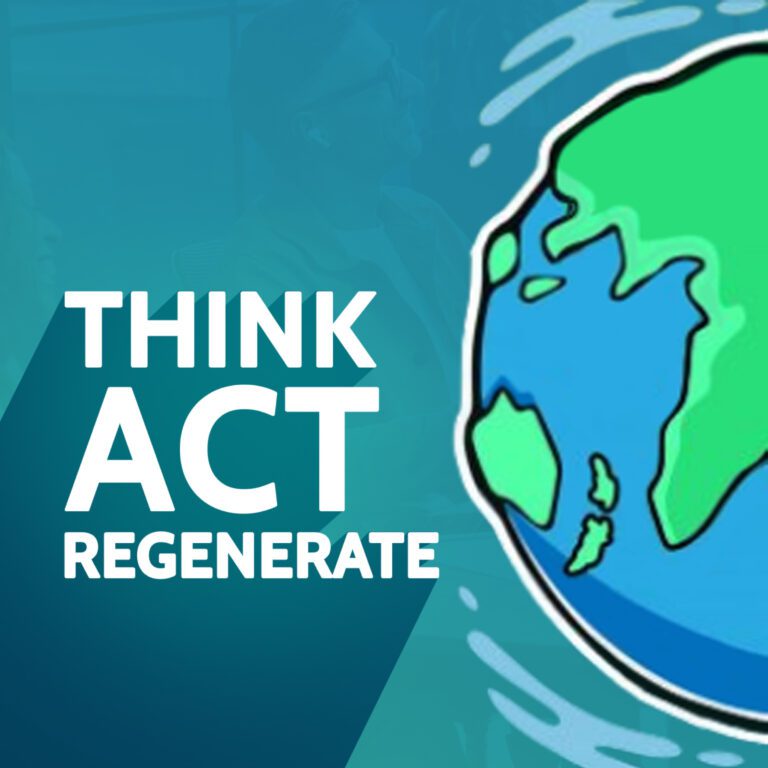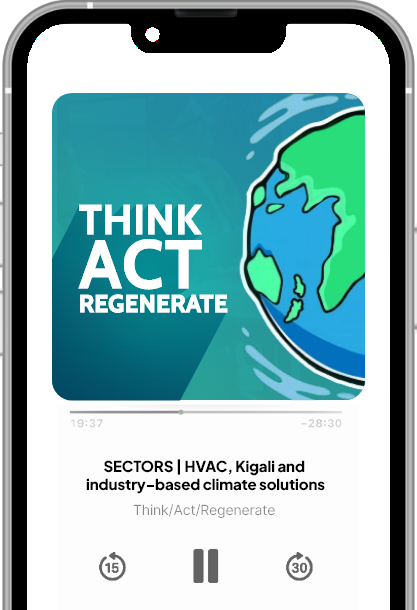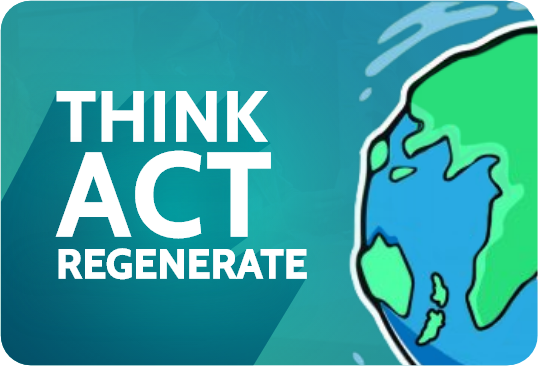
THINK ACT REGENERATE is a podcast by Leigh Baker of ThinkActRegenerate which explores the wealth of regenerative design solutions happening on the ground in Australia and New Zealand, as well as around the world.
A surprising number of people look at “sustainability” and “the environment” as onerous obligations instead of seeing it as a rich smorgasbord of business and career opportunity.
So they miss out on the wealth of commercial solutions coming to market – many of which are already scaling globally.
In the first of 10 Think Act Regenerate INSIGHTS, we explore the scope and scale of today’s opportunities and identify some starting resources.
FULL TEXT: https://thinkactregenerate.com/insight-a-world-of-business-and-career-opportunity/#text
LINKS
The Think Act Regenerate INSIGHTS email series: thinkactregenerate.com/insights
Project Drawdown’s solutions catalogue: drawdown.org/solutions
Ellen Macarthur Foundation for the Circular Economy: ellenmacarthurfoundation.org
Circular Design Guide: circulardesignguide.com
Project Regeneration’s Action Nexus: regeneration.org/nexus
Planning worksheet download of “An Ikigai for regenerative solutionists”: thinkactregenerate.com/an-ikigai-for-regenerative-solutionists
CREDITS
Original music composed for the show by Ian Hopkinson of HopkinsonCreative.com – used with permission.

A surprising number of people look at “sustainability” and “the environment” as onerous obligations instead of seeing it as a rich smorgasbord of business and career opportunity.
So they miss out on the wealth of commercial solutions coming to market – many of which are already scaling globally.
In the first of 10 Think Act Regenerate INSIGHTS, we explore the scope and scale of today’s opportunities and identify some starting resources.
LINKS
The Think Act Regenerate INSIGHTS email series: thinkactregenerate.com/insights
Project Drawdown’s solutions catalogue: drawdown.org/solutions
Ellen Macarthur Foundation for the Circular Economy: ellenmacarthurfoundation.org
Circular Design Guide: circulardesignguide.com
Project Regeneration’s Action Nexus: regeneration.org/nexus
Planning worksheet download of “An Ikigai for regenerative solutionists”: thinkactregenerate.com/an-ikigai-for-regenerative-solutionists
CREDITS
Original music composed for the show by Ian Hopkinson of HopkinsonCreative.com – used with permission.
TRANSCRIPT
We’re going to save a lot of money. We’ll make new revenues. And in fact, this is probably the biggest business opportunity in human history.
Dr Jonathan Foley, CEO Project Drawdown
Welcome to Think Act Regenerate, exploring the ways that thinking more broadly about today’s challenges is enabling deeper, More informed actions and delivering more positive regenerative solutions.
This podcast episode was recorded and produced on Wurundjeri land, just outside Melbourne, Australia.
In this and coming episodes, I’ll be exploring some key mindset shifts that I’ve seen repeated across regenerative business innovation over the last two decades.
I call these shift insights. Because insight is what I got as I uncovered them.
In 2021. I put these insights together into a short, free email series. There’s a link to this series in the show notes if what you hear today sparks your curiosity.
Today’s insight – the first insight- is about a subtle shift that’s happening. A shift away from compliance and reduction and authority thinking – a shift to opportunity thinking.
What opportunity? The opportunity to innovate. The opportunity to make a positive impact.
[00:02:00]
The opportunity to be part of a great can-do community. The opportunity to enhance your career or your business. And the potential to actively regenerate your bit of the world.
There’s a growing range of opportunities for efficiency, creativity, and impact. Particularly when you learn to see beyond the massively wasteful, one way, extract emit exploit business designs of the 20th century.
Those systems. are now showing up as massively inefficient when faced with a whole of life cost analysis.
Today’s regenerative design approach is about innovating the systems that deliver the products and the services that we use every day. And creating win-win- win outcomes to make the world better.
We can walk and chew gum. We can drive robots around on the surface of Mars and recycle launch rockets.
And we can upgrade our business models. So they restore and regenerate the communities and ecosystems that business does not exist without.
The innovators and entrepreneurs of the world have always thought in terms of creativity and improvement – probably since the first stone spearhead was chipped out of flint and traded for ochre and furs tens of thousands of years ago.
Today’s descendants of those original innovators- initially operating from college dorms research labs and garages instead of caves- have radically changed how the world communicates and created an ongoing information revolution.
And in parallel, their fellow inventors and entrepreneurs in -fields from architecture and chemistry to biology and industrial design- have been commercializing new solutions.
[00:04:00]
They’ve been creating smarter design tools. And they’ve been building more efficient implementation techniques. The result is solutions that deliver better products, better services, better business models. And better economic results.
And along with that, a rich smorgasbord of business career, and community development opportunities.
As Al Gore put it a while ago: “we are in the early stages of a technology led sustainability revolution with the scale of the industrial revolution and the speed of the information revolution.”
If you understand the drivers of that sustainability revolution and the principles behind it, then you could open up a range of new opportunities to make more impact and have more fun in the work you do and the life you live.
That’s what the Think Act Regenerate INSIGHTS series is fundamentally about. Giving you a new place to stand so you can find more of your opportunities.
So let’s talk opportunity.
There are already hundreds of commercial solutions to today’s social, economic, and ecosystem challenges. Solutions available and scaling in the marketplace today.
Opportunities exist across just about every industry sector.
The solutions we have today re-invent just about everything. Including food, transport, clothing, health, education, energy, agriculture, construction, manufacturing, cities, materials.
[00:06:00]
They are creating business opportunities, career opportunities and community development opportunities. Yet surprisingly few people see today’s solutions to today’s challenges as a PERSONAL opportunity.
We all participate in the complexity that we call “the economy”. As employees, as investors, as managers, as customers, as suppliers, as business owners, as governments and more.
Yet many people’s sense of agency is limited to lobbying their government, consuming less, and volunteering or campaigning in their spare time.
Yes, these things are vitally important. However, they’re not the full range of options and opportunities. And many traditional approaches that come from the top down don’t deliver lasting systems change.
Let’s look at the renewables industry. It’s just one example, but it’s one that’s fairly visible in the media.
Most people know that the renewable energy industry is expanding fast. And they understand that they could “help the environment” by installing solar panels and a battery at their home or buying an EV if they can afford it.
However renewables ares about more than buying rooftop solar and getting an EV. It’s a big industry. According to Polaris market research, the global renewable energy market was valued at over 1000 billion dollars US at the end of 2023. And it’s expected to grow by 8.6% per year from 2024 to 2032.
[00:08:00]
That cluster of global growth industries offers all sorts of opportunities. It offers trades jobs welding solar panel installations. It offers plumbing jobs, installing solar hot water systems, and IT jobs running regional smart grids.
And of course there’s a whole range of sales, support administration and management roles in every renewables business.
Plus there are the opportunities to. provide business services to this growth industry from recruitment and accounting to office rentals and fleet management.
It’s worth keeping in mind that the structure of the renewable energy industry isn’t just about domestic rooftop, solar and large-scale grid investments to replace coal fired power.
Today’s technology and business models also offer new and fairer delivery approaches, with community energy co-operatives spinning up their own regional energy retail operations, and even building solar gardens so they can offer renewable energy as a service to renters and apartment dwellers.
Also in the mix are solar panel and battery upcyclers as renewables industry leaders act to avoid the costly consequences of one way product designs and extractive business models by developing circular supply chains that minimize the high external costs of virgin materials, mining.
What’s my point out of all this?
The renewables industry is rich in business opportunity, rich in career opportunity, and offers regenerative community development opportunity as well.
Along the same lines, less visible innovations in other sectors offer broader opportunities when you start to look for them.
[00:10:00]
Whether it’s a factory that creates habitat like a forest as Ford did with their green roof in Dearborne – or living buildings that supply their own water and process their own waste.
We have much more information than we had a decade ago about the scope and scale of today’s solutions and opportunities.
They cover not only energy, but transport food, agriculture, land use, construction, manufacturing, health, and education.
So if you’re engaged in the world of work – or planning to engage – or running a business or investing for retirement, or helping a teenager with career planning, or you want to improve your local community, then they’re well worth knowing about.
Thanks to the information revolution, we have sources and resources available and, accessible that can guide us in finding our best individual opportunities.
There’s way too much going on for any podcast episode or any podcast to cover.
What IS worth covering in this episode are some starting points and some key resources, to give you an understanding of the full spectrum of solution scaling today. And to give you the tools to start exploring for your opportunities.
All the links to these resources will be in the show notes, and there’s more detail in the insights, email series on the think act regenerate website.
Let’s start with Project Drawdown, an independent research organization that has been quantifying today’s commercial solutions since 2014.
[00:12:00]
Their tally of the evidence-based commercially availables olutions scaling globally currently sits at 93. They also estimate that those 93 commercial solutions collectively deliver on 15 of the 17 UN sustainable development goals. And that they offer 74 trillion in savings by 2030.
Their solutions list – freely available online. it ranges from abandoned farmland restoration – through LED lighting and micro grids – to water distribution efficiency.
It’s well-worth exploring their current list at drawdown.org/solutions.
There’s a powerful regenerative design shift that goes by the name of circular economy. A lot of people have actually heard circular economy mentioned but think of it as better recycling of existing products.
That assessment is as useful as only using a smartphone to make voice calls.
The circular economy involves: product design, product life cycle, supply chain design, end of life design, closed loop supply chains and much more.
The Ellen MacArthur foundation for the Circular Economy has substantial resources on how the transition to a regenerative circular economy is developing across business, education, finance, the built environment, fashion and food.
They estimate the economic growth potential of scaling today’s known circular economy innovations at 1.8 trillion euros per year in the EU.
[00:14:00] They have education and industry resources available at ellenmacarthurfoundation.org. And they have also collaborated with design house iDEO to build how-to guides that you can access freely at circulardesignguide.com.
The final resource I’m going to talk about today is for people seeking more personal, community and SME resources. In that case, the Project Regeneration Action Nexus could be for you.
The action nexus lists 73 actionable solution sets – solutions open today to individuals, communities, SMEs, and regions. Its comprehensive list of action opportunities ranges widely – from afforestation through heat pumps and hemp to wind energy and a whole lot more.
regeneration.org/nexus is the link to their catalog.
Opportunity is where you look for it. The human brain runs on the equivalent of an old fashioned 40 watt light bulb. For the majority of us, living busy lives in a complex world what we notice is limited by what we know to look for.
We’ve been told repeatedly about how governments need to make better policy. And consumers need to consume less and governments need to do more regulation. So it’s rather easy to think that that’s all there is to do.
However inventors keep inventing and entrepreneurs keep turning their inventions into commercial solutions in the marketplace. So today there’s much more to building a brighter future than lobbying your local politician and being a good little consumer.
As Project Drawdown CEO, Dr. Jonathan Foley puts it:
[00:16:00]
This is incredible because we’re going to save a lot of money. We’ll make new revenues. And in fact, this is probably the biggest business opportunity in human history.
When you understand the wealth of opportunities that exist today and where to look for them then your brain will start asking different questions and showing you new opportunities.
If you’re interested in the opportunity side of this sustainability thing, those are some starting points.
If you’d like a little bit of structure to get you started, then there’s a worksheet I put together a while ago. the post is called. ” an Ikigai for regenerative solutionists”. I’ll put a link in the show notes to it.
Over coming episodes, I’ll be talking about the other nine insights that I find to be useful perspectives as you start a journey into regenerative design and regenerative business.
As well. I’ll be talking to people about the opportunities they’re finding and the opportunities they’re making for themselves in the world today.
If you don’t want to wait for those episodes then check out the Think Act Regenerate INSIGHTS email series, which will give you more details, resources and examples.
Thanks for listening to this episode of the think act regenerate podcast.
I’m Leigh Baker and I’ve enjoyed being your host today. I hope you found something to interest and provoke your in today’s episode.
If you liked the episode, then please leave a rating and review to help other people find their opportunities.
And if you want more ideas and more insight, then hit the subscribe button.












